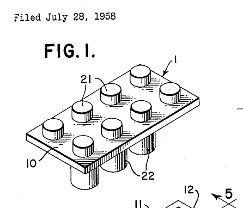We all seem to love Lego but what is it about this humble brick that has captured the imaginations of so many generations of kids? Inspired by the discovery of the US 1961 patent Tanya Weaver takes a look
Play-Doh, Meccano or Lego? A question posed to each of our ‘60 second interview’ candidates. I’d say nine times out of ten the answer is Lego.
In fact, my answer would be Lego too. Although this is more by process of elimination than favouritism. I’ve never played with Meccano and brick or two and can confirm that it’s no fun standing on one when barefoot.
So, it was a big yellow box of Lego for us, which acquired more pieces with each birthday and Christmas. It would be tipped out onto the carpet, providing endless hours of play for my sister and I as we snapped together and pulled apart these colourful bricks immersing ourselves in imaginary worlds.
And I think this is the appeal for most — the remembrance of the creativity it affords. Actually, the Denmark-based company boasts that six 2×4 pieces can be combined 915,103,765 ways.
It also doesn’t matter when you bought your set because Lego pieces of all varieties constitute a universal system. In other words, those made in 1958 will still interlock with those made today.
So, why this sudden interest in Lego? Well, I saw the original 1961 US Lego patent popping up on the internet recently. The reason being that a gallery in Florida — The Oliver Gal Artist Co. — has sourced the patents of a number of inventions, including the ‘Toy building brick 1961’, and reworked them into large framed prints. (They’re pretty cool actually).
A quick search on Google Patents and I came across the original description for this patent, which goes into quite some detail showing just how clever it actually is. “…the principal object of the invention is to provide improved coupling means for clamping such building bricks together in any desired relative position thus providing for a vast variety of combinations of the bricks for making toy structures of many different kinds and shapes.” (For those who’d like a more in-depth description of this coupling visit google.com/patents/US3005282).
Interestingly, Lego’s founder Ole Kirk Christiansen, a carpenter who set up his wooden toy company Lego, from the Danish phrase ‘leg godt’ which means ‘play well’, in 1934 can’t be credited with inventing this building brick.
He rather adapted the ‘Kiddicraft Self-Locking Building Brick’, which was patented by British inventor Hilary Fisher Page years earlier. But having bought the rights to the Kiddicraft block, discovering ABS plastic and purchasing an injection moulding machine (apparently the first moulding machine in Denmark for toy production) and his business took a whole new turn.
So, essentially a toy empire has been built off one little brick. And that’s no exaggeration as Lego has been named ‘Toy of the Century’ by both Fortune Magazine and the British Toy Retailers Association. But what keeps it so successful and makes us love it so much? It can’t just be the ‘oldies’ encouraging their kids to play with Lego because of nostalgia for a childhood brand.
No, Lego has reinvented itself and rather successfully at that, despite a blip in the early 2000’s when things weren’t looking quite so rosy. From introducing mini figs in 1978, educational toys in the 1980s, the first LEGOLAND family park in 1996, online games in 2010, girl-specific Lego Friends in 2012,and Lego MINDSTORMS EV3 in 2013, Lego has remained relevant to children, especially in our digital age.
It’s a company I admire too because it’s built on strong brand values. I remember interviewing one of its 180 designers for issue three of DEVELOP3D (yes, that was six years ago).
Mike Ganderton, who at the time was working on the Bionicle product line, said that Lego is a rewarding product to design because its purpose is to give kids enjoyment and allow them to express their creativity.
So long may kids enjoy Lego and, of course, adults too, as one of our previous ’60 second candidates’ David Fisher admitted: “I still buy Lego sets for myself and have three kids who try to steal it from me when they find the kits stashed in my studio.”
In fact, Lego has an acronym for such like you — AFOL (Adult Fans of Lego) and you can admit your addiction in the LUG (Lego User Groups) club. Find one online now. You won’t be alone.
Tanya Weaver considers the appeal of this humble brick
Default







